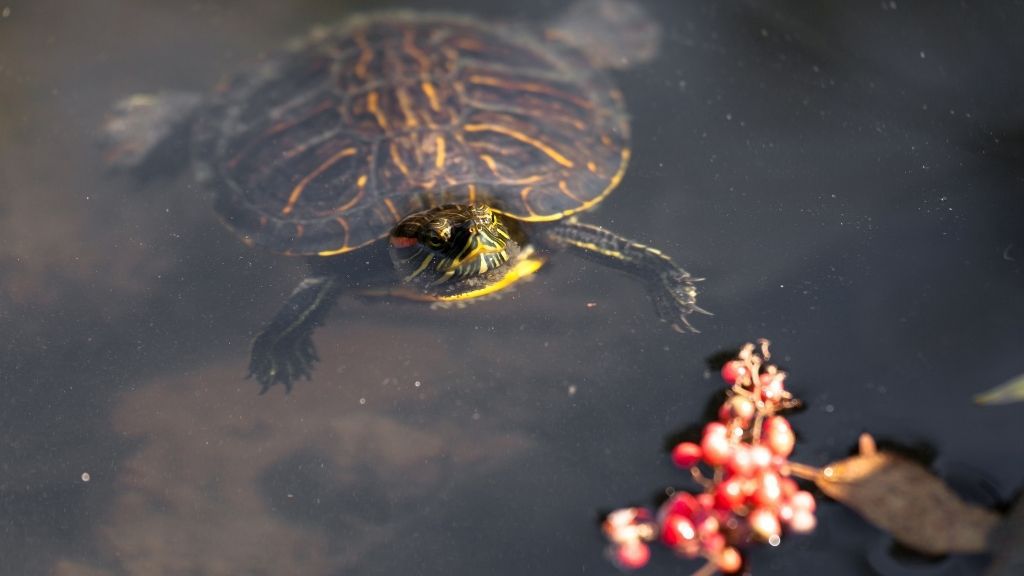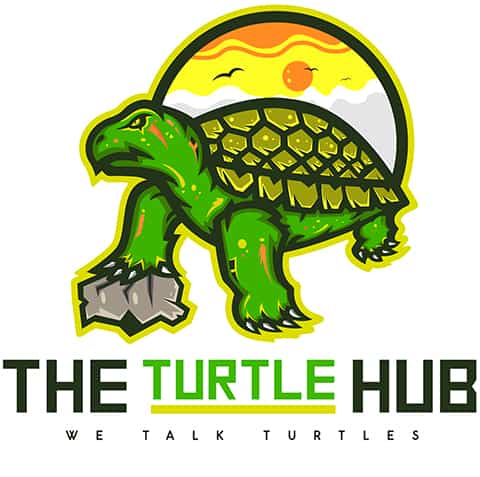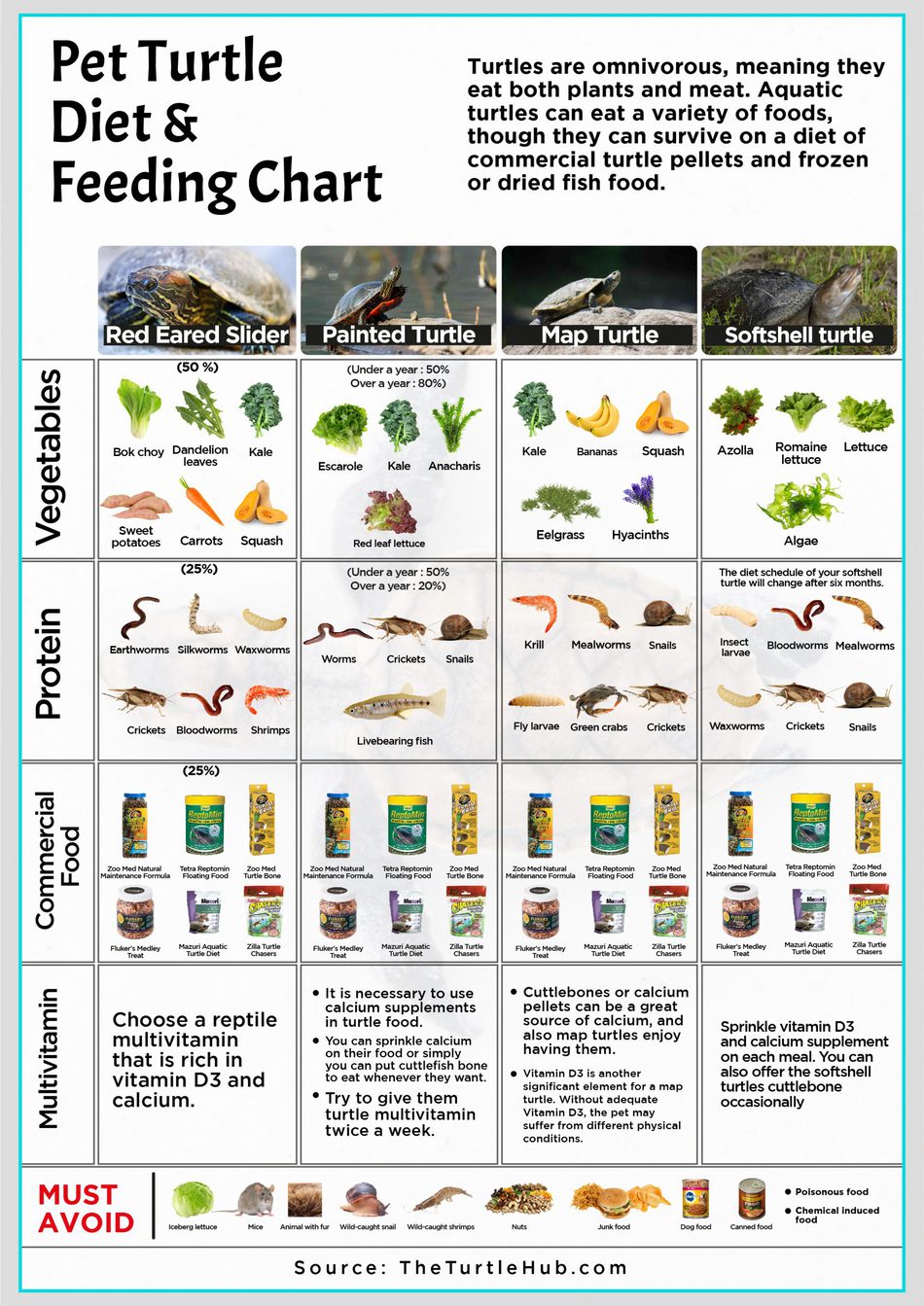Tags:
Greens To Proteins: A Guide To Feeding Red-Eared Sliders


fact checked & review by
Dr. Partho Kumar Shaha
Veterinarian (DVM)
The information is current and up-to-date in accordance with the latest veterinarian research.
The red-eared slider can be a great starter turtle for the beginners. However, many beginners often mess this up when it comes to feeding their red-eared slider. In most of the cases, red-eared sliders don’t live very long in captivity due to poor diet and feeding. In this article, I’ll talk details about red-eared slider turtle feeding and how to provide them a balanced diet every day.
General Guidelines When Feeding Turtles:
- The first thing you need to do is choose a food that has both protein and vegetable base in it. Hatchlings need about 75% protein and 25% vegetables and the adults need 75% vegetables with 25% protein. Keep in mind that, initially baby turtles need more protein in their food. As they grow up, they need more vegetables eventually.
- Turtles love dark green leafy vegetables. You can also feed them carrots every day. However, baby turtles should only eat vegetables once or twice a week.
- Like humans, turtles need calcium in their diet too. Calcium helps to strengthen a turtle’s bone and shell. So, you may wonder how to give turtles calcium as they can’t drink milk as we do. Actually, it is quite straightforward. You can easily buy a turtle calcium bone from any local pet store. These bones work as a great calcium source for turtles. If you don’t want to spend money on a calcium bone, then you can make some on your own. Take some eggshells, bake them 30 minutes in the oven at 300 degrees Fahrenheit and grind them in a blender. Next time when you are feeding your turtle, sprinkle some of these in the water.
- If you have an adult turtle, then a feeder fish will be a great addition to your turtle tank. Feeder fish entices the hunting instinct of turtles. They help to keep your turtle entertained too! Adding 1 fish per day is enough for an adult turtle. remember to remove the wastes after the turtle has finished eating.
- To save money and time, whenever you are buying food for your turtle, remember to buy in bulk amounts. Keep the food in a dry, cold area to preserve it longer.
Proper Diet for Red Eared Slider:
A proper diet for red-eared sliders should consist of 25% live protein, 25% commercial food and 50% vegetables with water plants. Many owners often do the mistake of only feeding their turtle the commercial food. It is a very poor practice and may lead your turtle to different diseases and early death.
- Some safe vegetables for red-eared sliders are dandelions, mustard greens, tops of carrots, bell pepper, squash, Romanian lettuce etc. Always check beforehand that no pesticides have been used on the vegetables.
- Some preferable safe water plants for turtles are water lettuce, water hyacinth, Frogbit, Anacharis, duckweed as well as hornwort. These plants don’t ask much to grow. You can keep them in a separate enclosure. they cost little when you buy in bulk.
- Fruits should only be given to red-eared sliders as a treat. Red-eared sliders don’t get to eat fruits in the wild. Feeding these often can cause various health problems. Banana is a good choice.
- When deciding a commercial food, choose one that has low protein and low fat. Never buy dried shrimps for your turtles. They are like fast food for turtles. Your turtles will get nuts for these, but these have no nutritional value what so ever.
How Often Should You Feed A Red-eared Slider?
Red-eared sliders have a huge appetite, which means they can literally tuck in any food that comes their way. Even if you feed it a good portion of ground beef, it will still remain gluttonous. It’s as hungry as like that!
However, you shouldn’t make the big mistake of continuously giving your slider some food. Consumption of too much food can lead to obesity, fatty liver disease, or even death!
The only way you can prevent such health issues is by maintaining a healthy diet routine. The diet of red-eared sliders varies on what you give them and their age.
Hatchling and juvenile sliders grow quickly, so it is recommended that you feed them at least once per day. They should be fed a higher percentage of protein (70%) than vegetables (30%). You can also include pellets as a quarter part of their protein-based diet.
Although hatchlings are likely to reject vegetables, you should still offer them in small amounts daily. Alongside, you should feed them protein, whether pellets or insects daily.
Juvenile sliders might consume vegetables, so you should introduce them to the different varieties. When it comes to protein-based meals, you can treat your turtle every now and then.
On the other hand, adult sliders don’t require to be fed more often. You can offer them vegetables at least thrice a week and protein once a week. Unlike baby sliders, adults should be fed more vegetables and less protein.
Red-eared Slider Feeding Schedule
As you know already, red-eared sliders are voracious species. Satisfying their hunger with more than what their body needs put them at a risk of health issues and even death. So, it is ideal to follow a proper feeding schedule for your pet.
- Hatchling: If your slider is less than six months old, you should feed it daily. They like to consume more protein-based foods at this stage, which is crucial for their growth. Whichever food you feed them, make sure it is about the size of its head.
- Juvenile: If your slider is aged six months to two years, you should feed it daily. You can introduce it to different vegetables regularly and protein sources occasionally.
- Adult: If your slider is more than two years old, you’ll have to feed it at least three times a week. It requires a greater portion of vegetables than protein.
Does Red Eared Sliders Need Nutritional Supplements?
Yes, you should provide nutritional supplements to your turtle’s diet. Choose a reliable reptile multivitamin that has calcium and vitamin D3 in it. Mix it a couple of times a week with the turtle’s food. These nutritional supplements will ensure your turtle is getting a 100% balanced nutrition profile.

Red Eared Slider Turtle Food List:
Each meal of your red-eared slider turtle should consist foods from the following list within each category:
| Vegetable (50%) | Protein (25%) | Commercial Food (25%) | Fruits (Occasional Treats) | Nutritional Supplements (Twice a week) |
|---|---|---|---|---|
| Mustard greens | Earthworms | Choose a commercial food with low fat and low protein. Click here to browse through different turtle commercial foods. | Shredded apples | Choose a reptile multivitamin that is rich in vitamin D3 and calcium. |
| Collard greens | Silkworms | Bananas | ||
| Dandelion leaves | Waxworms | Melons | ||
| Bok choy | Bloodworms | Berries | ||
| Kale | Crickets | Grapes | ||
| Romanian Lettuce | Daphnia | Peaches | ||
| Sweet potatoes | Small Aquatic Snails | Plums | ||
| Squash | Meal worms | Nectarines | ||
| Carrots | Krill | |||
| Green beans | Shrimps | |||
| Endives | Feeder fish | |||
| Tomatoes | Cooked beef | |||
| Parsley | Cooked chicken | |||
| Swiss chard | Tubifex worms | |||
| Turnip greens | Feeder fish may carry parasites or germs with it. So Choose carefully. | |||
| Water hyacinth | ||||
| water lillies | ||||
| Duckweed | ||||
| Elodia | ||||
| Frogbit | ||||
| Water lettuce | ||||
| Azolla (moss) | ||||
| Never feed Iceberg lettuce to turtles as these have no nutritional value |
Food Red-eared Sliders Can’t Eat
While it is recommended you feed your red-eared slider a variety of foods, there are some foods that are worth staying away from. That’s because your slider won’t be able to digest those foods, and can fall sick. Below is the list of foods that you should avoid giving to your slider.
- Chard
- Spinach
- Rhubarb
- Cabbage
- Bok-choy
- Broccoli
- Brussel sprouts
- Radishes
- Iceberg lettuce
- Unripe tomatoes and tomato plants
- Potato leaves
- Tobacco leaves
- Dairy foods
- Fatty foods
- Bakery foods
- Sugary foods
- Wild-caught prey
Explanation:
Chard, spinach, and rhubarb contain high levels of oxalic acid, which inhibits calcium absorption.
Cabbage, bok-choy, and broccoli contain oxalates, so they can cause kidney failure and thyroid problems in red-eared sliders.
Brussel sprouts and radishes should be avoided because the goitrogens present in them can cause improper functioning of the thyroid gland.
Although iceberg lettuce doesn’t have the chemicals that can contribute to potential health issues, its high water content provides zero nutritional value. Regular consumption of this particular veggie can lead to malnourishment.
Unripe tomatoes and tomato plants (leaves and vines) can be toxic to sliders, so they should be avoided.
Potato leaves and tobacco leaves are also toxic to sliders.
As for dairy products, red-eared sliders can’t digest them. That’s because their stomach doesn’t have the enzymes needed to break down lactose.
Fatty foods should be highly avoided as they can cause kidney failure and obesity.
Bakery and sugary foods, such as bread and chocolates shouldn’t be fed as they can cause digestive problems.
Lastly, you should never feed your slider wild-caught prey, such as raw fish and meat. If they have intestinal parasites, they can greatly affect the health of your pet.
Feeding Red-eared Sliders Fruits
Of course, your red-eared slider’s diet shouldn’t be limited to vegetables. You can give them a variety of fresh fruits, but only as occasional treats. As fruits contain high levels of sugar, feeding these on a regular basis can cause diarrhea. Below is a list of fruits they can snack on.
- Apples
- Bananas
- Berries
- Watermelons
- Strawberries
- Pears
- Grapes
- Mangoes
- Kiwi
- Cantaloupe
- Plums
- Carambola
Tips on Feeding Feeder Fishes To Turtles:
- Goldfish, guppies, mollies, platies, swordtails, minnows etc. can be a good feeder fish for red-eared sliders.
- Feeding feeder fishes help to stimulate the hunting instinct of turtles which is good for their health.
- The turtle should eat the entire fish with guts and all. It comes with a whole nutritional package.
- Oily fishes such as Smelt, mackerel should be avoided or fed occasionally.
- Wild caught fish is not recommended for feeding turtles as they can carry parasites and other types of germs with them.
- The protein part of the diet should consist 50% for adults and 70-80% for baby turtles.
- I don’t like giving frozen fish to my turtles. If you want, you can, however, it is not recommended because by freezing a fish, the vitamin B1 gets destroyed.
- Cooked protein like beef and chicken doesn’t have a balanced nutritional profile. They also make the water dirty very quickly. If you want to feed cooked protein to your turtles, it is better if you do that in a separate tank where the water quality won’t be an issue. These types of proteins should only be given as a treat and variation to the diet.
- I never recommend giving raw meets to turtles in captivity. Raw meets can possess various types of bacterial contamination and it will be a huge health risk for both your turtle and yourself.
Tips on Feeding Vegetables To Turtles:

- Try to feed vegetables that float on the water. These types of vegetables are great because your turtle can nibble on them whenever it prefers.
- Don’t forget to take out the leftover vegetables every day. Otherwise, they will get rotten and destroy the water quality of the turtle tank.
- Never feed iceberg or head lettuce to turtles as they consist of mostly water and do not possess any worthy nutritional value.
- Always check a water plant before you give it to the turtle. some water plants tend to be toxic to turtles. So, always be sure what you are giving.
- Whenever you are feeding fruits, keep in mind that they disintegrate quickly in the water and create a mess. So, it is better to feed your turtle fruits in a separate bowl or tank.
- If you have a baby turtle, then it is better to shred the vegetables so they can eat them easily. It is not important for an adult turtle.
- Fruits are not a natural part of red-eared slider turtles’ diet. In the wild, they don’t have any access to fruits. That doesn’t mean you can’t give them any. Fruits are fine for turtles, only if you give them in very little amount only as a treat. Too many fruits can cause diarrhea in turtles.
Why isn’t my red eared slider eating?
There can be a number of reasons for red-eared sliders refusing to eat. Some of them are:
- Not having enough swimming place
- Not having a basking area
- Incorrect temperature ranges in the enclosure
- No UVB light
- Boring food i.e. giving the same type of food every day
- Getting stressed for some reason
- Any sudden change to the enclosure
- Any sudden change in the environmental temperature
- Being ill or having some health issues such as respiratory infection

What do red-eared sliders eat in the wild?
Red-eared sliders are omnivorous. They eat various types of foods in the wild such as:
- Aquatic vegetables and water plants
- Small Fishes
- Frogs
- Dead fishes
- Grasshoppers
- Caterpillars
- Earthworms
- Spiders
- Flowers
- Grass
- Berries
- Over-ripped fruits fallen from the tree
- Carrions etc.
Do Red-eared Sliders Need To Eat Every Day?
As mentioned earlier, it is essential that you feed hatchling and juvenile red-eared sliders every day. That’s because they have a faster metabolism rate, and they grow quickly. You can keep feeding your slider daily until it reaches two years of age.
How Many Pellets To Feed Red-eared Slider?
If you’re going to feed pellets to your red-eared slider, you’ll need to take as many pellets as the size of its head. You shouldn’t worry about the number of pellets in this case.
Frequently Asked Questions:
How often to feed my red eared slider?
It all depends on the size and age of your turtle. if you have a young turtle, then you need to feed it every day. On the other hand, adult turtle needs feeding only twice or thrice a week. With age, the diet should also get changed from protein-focused to vegetable focused.
Does my red eared slider need nutritional supplements?
You might think that as the red-eared slider is getting a balanced and diverse diet, there is no necessity for any additional nutritional supplements. You are wrong. There is some rare nutrition that is hard to provide even with a balanced diet. That’s why it is always recommended to give your turtle a reptile multivitamin at least twice a week.
Doesn’t my red eared slider need to drink water?
Yes, it does. However, you don’t have to think about it as your turtle can swim in the water and drink it whenever it needs. You do need to pay attention to keep the water quality as much clean as possible.
Can a red-eared slider turtle eat apples?
Yes, you can give shredded apples to your red-eared slider. However, only give them as a treat as apples are rich in sugar quantity.
What kind of human food can you feed a turtle?
These are some of the human foods that a turtle can eat without any problem: potatoes, green beans, apples, berries, bananas, carrots etc.
Can red-eared sliders eat cucumbers?
Yes, they can eat cucumber. However, cucumbers don’t get to possess that much nutritional value. It is more like a filler. You can add them once in while in the diet to diverse things.
Can a turtle eat bananas?
Yes, turtles can eat a banana. However, due to the high sugar quantity, only give bananas to them sparingly as a treat.
Can a turtle eat chicken?
Yes, turtles can eat chicken. But you need to cook it. Raw meats are not safe for turtles as they tend to carry various types of bacteria. I don’t recommend feeding cooked chickens or beef very often to turtles.
Can my turtle eat tomatoes?
Yes, you can feed your turtle tomatoes. Many turtles actually enjoy eating them. But too much tomato is bad for them. It is safe to feed tomatoes only once a week.
Can red-eared slider turtles eat grapes?
Yes, they can eat grapes and even enjoy it. However, never feed grapes often to your turtles as they contain high sugar and your turtle may get diabetes from it. Only feed grapes as an occasional treat.
Can turtles eat lettuce?
Yes, turtles can eat lettuce. But only feed Romanian lettuce to them as the iceberg lettuce mostly contains water and has no nutritional value what so ever.
Can turtles eat watermelon?
Watermelons are fine only as an occasional treat.
Can turtles strawberries?
Not only strawberries, turtles can eat different types of berries such as raspberries, blueberries etc. however, only feed them sparingly as a treat.

About Author
Muntaseer Rahman started keeping pet turtles back in 2013. He also owns the largest Turtle & Tortoise Facebook community in Bangladesh. These days he is mostly active on Facebook.
Disclaimer
This site is owned and operated by Muntaseer Rahman. TheTurtleHub.com is a participant in the Amazon Services LLC Associates Program, an affiliate advertising program designed to provide a means for sites to earn advertising fees by advertising and linking to Amazon.com. This site also participates in other affiliate programs and is compensated for referring traffic and business to these companies.

